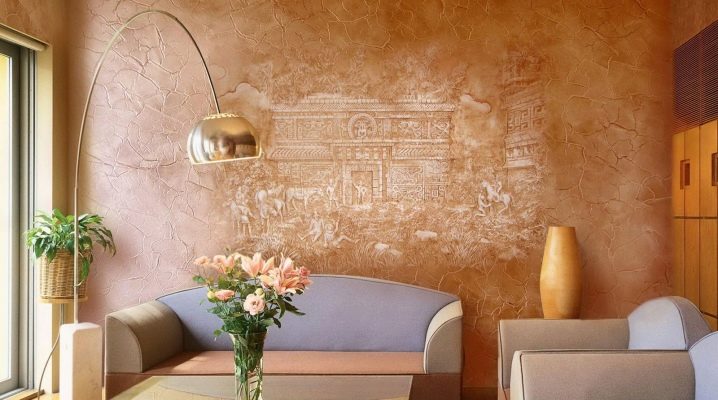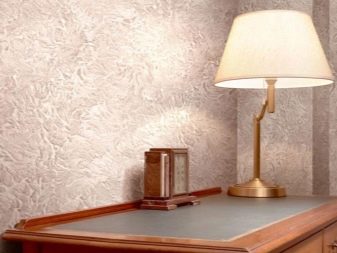Textured plaster in interior design

Today, the domestic building materials market offers a wide variety of finishing materials. One of the varieties is textured plaster, which is very popular not only among amateurs, but also professional craftsmen and room designers. It is important to think in advance about why it is better to use textured plaster in corridors and hallways, and with direct use, you should know exactly what features and advantages it has.





What is the material
To create a fashionable and modern interior today, you have to keep up with the times and use the latest innovations and scientific achievements.
Textured plaster is a relatively new invention, however, it has become especially popular only in recent years. Textured plaster is a special type of conventional plaster, however, to a greater extent it refers to decorative finishing materials with a relief effect. However, this material is suitable for both interior and exterior decoration work.


With the help of this type of plaster, you can achieve a very unusual relief on the walls, without resorting to the use of special tools and additional tools. Moreover, you can complete the finishing work yourself, without seeking help from specialists.
Textured plaster is considered very viscous, it can include a variety of components, depending on the manufacturer. In general, such building materials are considered safe for humans and the environment. You can find this kind of products in various colors and shades. In addition, if the color you want is not there, you can easily create it using a color scheme, while adjusting the required shade intensity.

Features and Benefits
To know for sure whether this finishing material suits you or not, very it is important to consider its positive qualities and some features:
- The embossed effect of plaster is created due to the special composition of the mixture. When applying such material to the walls with a spatula, you can create the most unusual and original patterns and designs.
- In the composition of the material, you can find stone chips, special granules and various fibers.


- Textured plaster can be used to replace other finishing materials, such as wallpaper. The effect will be just as good. So, with the help of this mixture, you can recreate a cut of wood, brickwork, a bas-relief on the walls or on the ceiling, as well as create various patterns under the skin of a crocodile and a snake.


- Many manufacturers produce decorative plaster in a ready-made form, but among a wide range you can also find dry mixes that are designed for individual preparation.
It is difficult to say which one is the best, since the result will depend on the characteristics of the room you are going to decorate.


- The textured mixture does not have to be white. So that you do not spend a long time looking for a suitable color scheme, you can easily find a lot of color options on the shelves of many stores. Moreover, the mixture itself can be matte, glossy, and pearlescent.


- Many designers and builders choose textured plaster even for problem walls and ceilings.Indeed, before applying them, it is not necessary to level them, since the mixture will be able to cover even significant disadvantages.

Usually, only a special primer is applied for the best adhesion to the surface.
- With this type of material, you can create a solid surface without unnecessary joints and seams. In addition, if you are not satisfied with the ready-made colors of the raw materials, you can easily create a special shade, add mother-of-pearl or other glitters to it.

- Among a wide range of options, you can choose plaster for both classic and modern interiors.
- Thanks to the perfectly matched composition, such a finishing material will serve you for many years without losing its former presentable appearance. In addition, over time, cracks do not form on the surface covered with plaster, and it will not wear off.


Compared to similar building materials, the advantages of textured plaster are obvious. It is unique in its own way, and such a relief effect is quite difficult to achieve using similar compositions. But, of course, the choice in favor of this or that material always remains with the consumer.
You can learn more about the benefits of decorative plaster by watching the following video.
Wide range of
On store shelves, you can find decorative plaster for a variety of interior design not only from domestic but also foreign manufacturers. Of course, the latter options can be more expensive.
The main types of decorative plaster, which some experts share in composition:
- Mineral. This variety is mainly sold in dry mixes and powders. Suitable for covering stone surfaces and for rooms with high humidity, since it is not afraid of temperature changes.

- Silicone. Such plaster is most often represented by a ready-made mixture. It is suitable for finishing a wide variety of surfaces, including unprepared ones.

- Acrylic. Like the previous variety, it can be suitable for decorating a wide variety of surfaces;

- Silicate. The mixture is based on potassium and sodium silicates.

- Polymer is popular a variety that consists of acrylic resins.

One or another type of plaster should be selected taking into account all the features of the room. Structural and textured plasters can easily mimic a wide variety of textures. It is not necessary to use special tools to create the drawing. A regular spatula or roller should be sufficient.
Textured plaster is mainly used to simulate natural stone or an aged and exotic surface.


Where is it applied?
A wide range of applications for decorative textured plaster is due to the fact that it lends itself to excellent adhesion to a wide variety of surfaces.
It turns out that with the help of decorative plaster, they not only complement the interiors of houses and apartments, it is also used as a full-fledged finishing material for facades and various external walls of buildings.

In interior design, using textured plaster, you can complement the walls and ceilings of the bedroom, living room, hall, hallway, kitchen and even the bathroom (when it comes to waterproof compounds).


Many experts prefer textured plaster as a finishing material. in the hallway and in the corridor, since these are precisely the rooms where the walls are very often dirty and worn out. On a textured surface, any flaws will be completely invisible due to such an unusual coating.

Since textured plaster is very simple and unpretentious to maintain, and many of its types are not afraid of moisture, you can easily cover surfaces in the bathroom and kitchen with it.


Basically, the scope of application of plaster in the interior of the house is limited only by imagination, so do not be afraid to experiment and bring to life the most unusual and daring ideas.
Interior options
With the help of textured plaster, you can make a beautiful zoning of one large room. It can be a living room combined with a bedroom, or a studio apartment, in one room of which you need to place two or three functional areas.

With the help of textured mother-of-pearl plaster, you can recreate a real sea wall in the living room, which can later be supplemented with decorative miniature shells.

By creating some specific drawings with a spatula, you can try to depict tropical leaves and palm trees.

The combination of plaster with other finishing materials looks very good. This technique is used by many professionals, decorating only one wall with plaster, and covering the rest with wallpaper. Sometimes one wall is covered with photowall-paper, and on all the others there is a beautiful textured plaster under the stone.

Also, do not forget that for small spaces it is best to use light-colored plaster, which will help visually expand the space. Light shades of finishing materials are also suitable for spacious rooms, but in this case they can be combined with brighter, darker and more saturated colors.

Many modern high-tech or techno interiors can also be complemented with finishing materials such as textured plaster. However, these styles only require the use of a cool palette of shades: dark, gray and white.

If you are not sure that you can independently choose the textured plaster of the desired type and shade for your home, it is best to use the services of real professionals and consultants for finishing materials.













The comment was sent successfully.